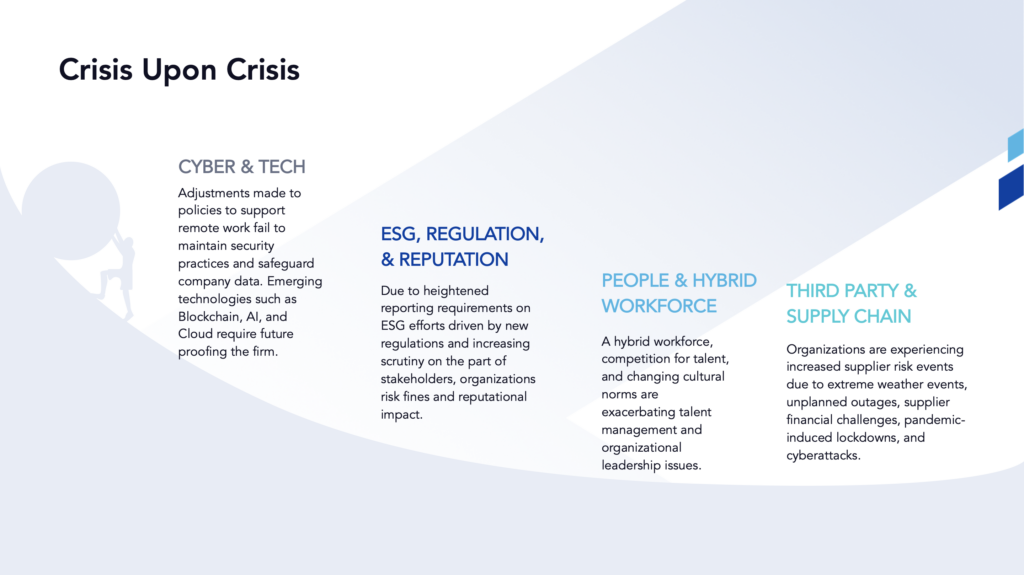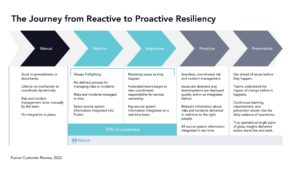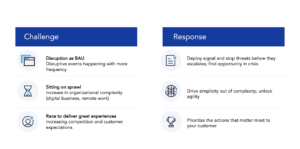Building Your Compass for Real-time Risk and Resiliency
Compass Customer Summit Series
 The Rise of Operational Intelligence
The Rise of Operational Intelligence
Prior to the pandemic, it was commonplace for organizations to operate their risk and resiliency programs out of spreadsheets, documents, and even post-its – if they had a program at all.
The escalating number of disruptions make it critical that businesses have the ability to identify and respond to risks and incidents swiftly and conclusively.
The pace of change is ever-accelerating, with a myriad of new high impact and high ambiguity risks surfacing on the horizon. Today’s risk and resilience teams understand that they need real-time data to drive operating intelligence, but many are challenged by siloed systems and limited resources.

Too often, organizations invest significant hours and dollars in the effort to mitigate risk and build resilience, only to find the task is as daunting and impossible as pushing a boulder up a hill.
To compound the challenge, as a result of the pandemic and its cascading impacts, the pace of digitization has hastened tenfold by some estimates. According to the recent MuleSoft Connectivity Benchmark Report, 72% of customer touchpoints are now digital, but only 28% of those enterprise systems are integrated. Teams are more siloed than ever before, with 90% of teams reporting significant business challenges posed by data silos.
This lack of connectedness across the enterprise has a swarm of impacts, including a firm’s ability to respond in crisis, with some estimates suggesting that the average organization is hemorrhaging $2.5 million per year due to inefficient risk detection and response.
The Journey from Reactive to Proactive
As a result of these shifts, leading risk and resilience teams have picked up the mantle of change, prioritizing the important services and products they are delivering to customers and creating value chains that are resilient by design. No longer in firefighting mode, these teams are leveraging integration to triangulate enterprise data, situational awareness, and operating context to inform connected and dynamic service and product chain maps, visual data navigators, and Google-like discovery tools that allow end users and executives to interrogate firm data on the fly using simple questions.

An increasing number of teams are getting ahead of issues before they escalate into crisis, with federated teams taking coordinated responsibility for service and product ownership. The technologies available today bring real-time perspective into any situation, spotting key vulnerabilities and single points of failure before disaster strikes, detecting issues, and deploying key assets in an integrated and frictionless fashion.
The most advanced teams are beginning to use Artificial Intelligence and Machine Learning to sense change correlations in their internal and external operating environment that are indicative of increased risk, escalating incidents, or, in some cases, efficiency or opportunity, driving continuous learning and preemptive action-taking.

Risk and resilience teams are increasingly thrust into the role of something akin to a nerve center for the modern and connected enterprise. In this new agile enterprise, while responsibility is federated, signals and connections that matter are integrated into an intelligent view of how the organization works together to deliver value for customers, how that motion is vulnerable to breaking, how to respond in a critical event, and how to improve your organization’s resiliency and agility over time.
“Firm-wide resilience is comprised of many things: third-party risk, cyber, failover, facilities… What I want to develop is a nerve center. Trying to figure out how to federate out the details to existing programs and create a holistic perspective from them. This is not starting with a blank slate… rather it is integrating to existing programs and hopefully uplifting them over time.”
Proactive response relies upon a fully integrated data foundation that allows your entire organization to connect the dots between key changes in your environment and the underlying impact to your business operations.
Conclusion
Data is the lifeblood of the connected enterprise, powering greater risk awareness, business agility, and operational resilience in times of continuous and protracted crisis.
Are you interested in learning more about Fusion’s integrated data foundation and some of the latest intelligent and dynamic capabilities that are powering resilience across the global ecosystem of enterprise?
Reach out to your Account Manager and watch the replay of our webinar focusing on The Road to Interactive Continuity and Response.



